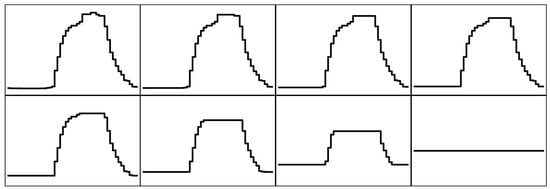Event Effects Estimation on Electricity Demand Forecasting
Abstract
1. Introduction
2. Literature Review
3. Proposed Method
3.1. Statistical Model
3.2. Construction of Event Effect and Parameter Estimation
3.2.1. Case 1: Basis Function Is Specified
3.2.2. Case 2: Basis Function Cannot Be Specified
- Determine the initial value of , such as .
- Repeat the following procedures until convergence.
- (a)
- (b)
- For fixed , minimize (2) with respect to . This problem reduces to the generalized lasso problem with the penalty term expressed as
4. Real Data Analysis
4.1. Irregular Events
4.2. Model Setting
4.2.1. Proposed Method
- VCM-S (Varying-coefficient model with simple basis function): our proposed method with simple basis function as in Figure 5a.
- VCM-FL (Varying-coefficient model with fused lasso): our proposed method with basis function estimated by fused lasso.
- VCM-S-Log: VCM-S with the logarithm transformation.
- VCM-FL-Log: VCM-FL with the logarithm transformation.
- VCM-Log: VCM with the logarithm transformation.
- Sep-S (Separate regression with a simple basis function): the regression coefficients associated with the weather effect are different in each time period.
- Sep-FL: separate regression with fused lasso.
- Sep: separate regression.
4.2.2. Existing Methods
4.3. Result
4.3.1. Forecast Accuracy
- For almost all methods, event information improves the accuracy.
- When event information is included, the VCM-FL-Log yields the best performance in both RMSE and MAPE. Basis expansion successfully captures the effects of both daily temperature and events. In addition, the logarithm transformation successfully improves accuracy when the event information is incorporated into the model.
- VCM-FL performs much better than VCM-S, implying that the event effect highly depends on the time period.
- The varying coefficient model performs slightly better than the separate regression.
- Interestingly, VCM-S provides a larger MAPE than VCM does, although the latter does not incorporate event information. A simple basis function can result in poor forecast accuracy when the event effect highly depends on the time period.
- For existing methods, SVR, RF, XGBoost, and LightGBM perform better than the lasso and ARIMA. This is probably because the lasso and ARIMA can capture only the linear relationship between temperature and demand, whereas SVR, RF, XGBoost, and LightGBM can capture the nonlinear structure.
- XGBoost and LightGBM yield similar accuracy because both are based on the gradient boosting decision tree.
4.3.2. Interpretation of Forecast Results
5. Conclusions
6. Patents
Supplementary Materials
Author Contributions
Funding
Acknowledgments
Conflicts of Interest
References
- Electricity and Gas Industry Committee. Available online: https://www.meti.go.jp/shingikai/enecho/denryoku_gas/denryoku_gas/ (accessed on 8 September 2020).
- Japan Electric Power Exchange. Available online: http://www.jepx.org/english/market/index.html (accessed on 8 September 2020).
- Suzuki, A. An Empirical Analysis of Entrant and Incumbent Bidding in Electric Power Procurement Auctions; Waseda Global Forum: Tokyo, Japan, 2010; p. 385. [Google Scholar]
- Vialetto, G.; Noro, M. Enhancement of a Short-Term Forecasting Method Based on Clustering and kNN: Application to an Industrial Facility Powered by a Cogenerator. Energies 2019, 12, 4407. [Google Scholar] [CrossRef]
- Chapagain, K.; Kittipiyakul, S.; Kulthanavit, P. Short-Term Electricity Demand Forecasting: Impact Analysis of Temperature for Thailand. Energies 2020, 13, 2498. [Google Scholar] [CrossRef]
- Lisi, F.; Pelagatti, M.M. Component estimation for electricity market data: Deterministic or stochastic? Energy Econ. 2018, 74, 13–37. [Google Scholar] [CrossRef]
- Energy Information Center. Available online: http://eic-jp.org/ (accessed on 8 September 2020).
- Iwafune, Y.; Mori, Y.; Kawai, T.; Yagita, Y. Energy-saving effect of automatic home energy report utilizing home energy management system data in Japan. Energy 2017, 125, 382–392. [Google Scholar] [CrossRef]
- Grolinger, K.; L’Heureux, A.; Capretz, M.A.M.; Seewald, L. Energy Forecasting for Event Venues: Big Data and Prediction Accuracy. Energy Build. 2016, 112, 222–233. [Google Scholar] [CrossRef]
- Grolinger, K.; Capretz, M.A.M.; Seewald, L. Energy Consumption Prediction with Big Data: Balancing Prediction Accuracy and Computational Resources. In Proceedings of the 2016 IEEE International Congress on Big Data (BigData Congress), San Francisco, CA, USA, 27 June–2 July 2016; pp. 157–164. [Google Scholar]
- Park, J.; Park, S.; Ok, C. Optimal factory operation planning using electrical load shifting under time-based electric rates. J. Adv. Mech. Des. Syst. Manuf. 2016, 10, JAMDSM0085. [Google Scholar] [CrossRef][Green Version]
- Hastie, T.; Tibshirani, R. Varying-Coefficient Models. J. R. Stat. Society. Ser. B (Methodol.) 1993, 55, 757–796. [Google Scholar] [CrossRef]
- Fan, J.; Zhang, W. Statistical Estimation in Varying-Coefficient Models. Ann. Stat. 1999, 27, 1491–1518. [Google Scholar]
- Hirose, K. Interpretable modeling for short-and medium-term electricity load forecasting. arXiv 2020, arXiv:2006.01002. [Google Scholar]
- Tibshirani, R.; Saunders, M.; Rosset, S.; Zhu, J.; Knight, K. Sparsity and smoothness via the fused lasso. J. R. Stat. Soc. Ser. B (Stat. Methodol.) 2005, 67, 91–108. [Google Scholar] [CrossRef]
- Tibshirani, R.J.; Taylor, J. The solution path of the generalized lasso. Ann. Stat. 2011, 39, 1335–1371. [Google Scholar] [CrossRef]
- Guo, Z.; Zhou, K.; Zhang, C.; Lu, X.; Chen, W.; Yang, S. Residential electricity consumption behavior: Influencing factors, related theories and intervention strategies. Renew. Sustain. Energy Rev. 2018, 81, 399–412. [Google Scholar] [CrossRef]
- Wang, F.; Liu, L.; Yu, Y.; Li, G.; Li, J.; Shafie-Khah, M.; Catalão, J.A.P. Impact analysis of customized feedback interventions on residential electricity load consumption behavior for demand response. Energies 2018, 11, 770. [Google Scholar] [CrossRef]
- Ruiz-Abellón, M.C.; Fernández-Jiménez, L.A.; Guillamón, A.; Falces, A.; García-Garre, A.; Gabaldón, A. Integration of Demand Response and Short-Term Forecasting for the Management of Prosumers’ Demand and Generation. Energies 2020, 13, 11. [Google Scholar] [CrossRef]
- Hong, T.; Fan, S. Probabilistic electric load forecasting: A tutorial review. Int. J. Forecast. 2016, 32, 914–938. [Google Scholar] [CrossRef]
- Ismail, Z.; Efendi, R.; Deris, M.M. Application of fuzzy time series approach in electric load forecasting. New Math. Nat. Comput. 2015, 11, 229–248. [Google Scholar] [CrossRef]
- Mir, A.A.; Alghassab, M.; Ullah, K.; Khan, Z.A.; Lu, Y.; Imran, M. A Review of Electricity Demand Forecasting in Low and Middle Income Countries: The Demand Determinants and Horizons. Sustainability 2020, 12, 5931. [Google Scholar] [CrossRef]
- Amral, N.; Ozveren, C.S.; King, D. Short term load forecasting using Multiple Linear Regression. In Proceedings of the 2007 42nd International Universities Power Engineering Conference, Brighton, UK, 4–6 September 2007; IEEE: Piscataway, NJ, USA, 2008; pp. 1192–1198. [Google Scholar]
- Dudek, G. Pattern-based local linear regression models for short-term load forecasting. Electr. Power Syst. Res. 2016, 130, 139–147. [Google Scholar] [CrossRef]
- Saber, A.Y.; Alam, A.K.M.R. Short term load forecasting using multiple linear regression for big data. In Proceedings of the 2017 IEEE Symposium Series on Computational Intelligence (SSCI), Honolulu, HI, USA, 27 November–1 December 2017; pp. 1–6. [Google Scholar] [CrossRef]
- Contreras, J.; Espinola, R.; Nogales, F.J.; Conejo, A.J. ARIMA models to predict next-day electricity prices. IEEE Trans. Power Syst. 2003, 18, 1014–1020. [Google Scholar] [CrossRef]
- Hor, C.L.; Watson, S.J.; Majithia, S. Daily load forecasting and maximum demand estimation using ARIMA and GARCH. In Proceedings of the 2006 International Conference on Probabilistic Methods Applied to Power Systems, Stockholm, Sweden, 11–15 June 2006; IEEE: Piscataway, NJ, USA, 2006; pp. 1–6. [Google Scholar]
- Lee, C.M.; Ko, C.N. Short-term load forecasting using lifting scheme and ARIMA models. Expert Syst. Appl. 2011, 38, 5902–5911. [Google Scholar] [CrossRef]
- Takeda, H.; Tamura, Y.; Sato, S. Using the ensemble Kalman filter for electricity load forecasting and analysis. Energy 2016, 104, 184–198. [Google Scholar] [CrossRef]
- Engle, R.F.; Granger, C.W.; Rice, J.; Weiss, A. Semiparametric estimates of the relation between weather and electricity sales. J. Am. Stat. Assoc. 1986, 81, 310–320. [Google Scholar] [CrossRef]
- Harvey, A.; Kopman, S.J. Forecasting Hourly Electricity Demand Using Time-Varying Splines. J. Am. Stat. Assoc. 1993, 88, 1228–1236. [Google Scholar] [CrossRef]
- Cabrera, B.L.; Schulz, F. Forecasting Generalized Quantiles of Electricity Demand: A Functional Data Approach. J. Am. Stat. Assoc. 2017, 112, 127–136. [Google Scholar] [CrossRef]
- Vilar, J.; Aneiros, G.; Raña, P. Prediction intervals for electricity demand and price using functional data. Electr. Power Energy Syst. 2018, 96, 457–472. [Google Scholar] [CrossRef]
- Shah, I.; Lisi, F. Day-ahead electricity demand forecasting with nonparametric functional models. In Proceedings of the 2015 12th International Conference on the European Energy Market (EEM), Lisbon, Portugal, 19–22 May 2015; pp. 1–5. [Google Scholar]
- Shah, I.; Iftikhar, H.; Ali, S.; Wang, D. Short-Term Electricity Demand Forecasting Using Components Estimation Technique. Energies 2019, 12, 2532. [Google Scholar] [CrossRef]
- Tibshirani, R. Regression shrinkage and selection via the lasso. J. R. Stat. Soc. Ser. B (Methodol.) 1996, 58, 267–288. [Google Scholar] [CrossRef]
- Ziel, F. Modelling and forecasting electricity load using Lasso methods. In Proceedings of the 2015 Modern Electric Power Systems (MEPS), Wroclaw, Poland, 6–9 July 2015; IEEE: Piscataway, NJ, USA, 2015; pp. 1–6. [Google Scholar]
- Ziel, F.; Liu, B. Lasso estimation for GEFCom2014 probabilistic electric load forecasting. Int. J. Forecast. 2016, 32, 1029–1037. [Google Scholar] [CrossRef]
- Zhang, P.; Wu, X.; Wang, X.; Bi, S. Short-term load forecasting based on big data technologies. CSEE J. Power Energy Syst. 2015, 1, 59–67. [Google Scholar] [CrossRef]
- Chen, Y.; Xu, P.; Chu, Y.; Li, W.; Wu, Y.; Ni, L.; Bao, Y.; Wang, K. Short-term electrical load forecasting using the Support Vector Regression (SVR) model to calculate the demand response baseline for office buildings. Appl. Energy 2017, 195, 659–670. [Google Scholar] [CrossRef]
- Elattar, E.E.; Goulermas, J.; Wu, Q.H. Electric Load Forecasting Based on Locally Weighted Support Vector Regression. IEEE Trans. Syst. Man Cybern. Part C (Appl. Rev.) 2010, 40, 438–447. [Google Scholar] [CrossRef]
- Jiang, H.; Zhang, Y.; Muljadi, E.; Zhang, J.; Gao, W. A Short-Term and High-Resolution Distribution System Load Forecasting Approach Using Support Vector Regression with Hybrid Parameters Optimization. IEEE Trans. Smart Grid 2016, 9, 3341–3350. [Google Scholar] [CrossRef]
- Dudek, G. Short-Term Load Forecasting Using Random Forests. In Advances in Intelligent Systems and Computing; Springer: Cham, Switzerland, 2015; Volume 323, pp. 821–828. [Google Scholar]
- Lahouar, A.; Slama, J.B.H. Day-ahead load forecast using random forest and expert input selection. Energy Convers. Manag. 2015, 103, 1040–1051. [Google Scholar] [CrossRef]
- Moody, J.; Christian, D. Learning with Localized Receptive Fields; Yale University, Department of Computer Science: New Haven, CT, USA, 1988. [Google Scholar]
- Moody, J. Fast Learning in Multi-Resolution Hierarchies. In Advances in Neural Information Processing Systems; 1989; pp. 29–39. Available online: https://proceedings.neurips.cc/paper/1988/file/82161242827b703e6acf9c726942a1e4-Paper.pdf (accessed on 6 November 2020).
- Moody, J.; Darken, C.J. Fast Learning in Networks of Locally-Tuned Processing Units. Neural Comput. 1989, 1, 281–294. [Google Scholar] [CrossRef]
- Ortiz-Arroyo, D.; Skov, M.K.; Huynh, Q. Accurate Electricity Load Forecasting with Artificial Neural Networks. In Proceedings of the International Conference on Computational Intelligence for Modelling, Control and Automation and International Conference on Intelligent Agents, Web Technologies and Internet Commerce (CIMCA-IAWTIC’06), Vienna, Austria, 28–30 November 2005; Volume 1, pp. 94–99. [Google Scholar]
- Karampelas, P.; Vita, V.; Pavlatos, C.; Mladenov, V.; Ekonomou, L. Design of artificial neural network models for the prediction of the Hellenic energy consumption. In Proceedings of the 10th Symposium on Neural Network Applications in Electrical Engineering (NEUREL 2010), Belgrade, Serbia, 23–25 September 2010; pp. 41–44. [Google Scholar]
- Ekonomou, L.; Christodoulou, C.A.; Mladenov, V. A Short-Term Load Forecasting Method Using Artificial Neural Networks and Wavelet Analysis. Int. J. Power Syst. 2016, 1, 64–68. [Google Scholar]
- Kutbatsky, V.; Sidorov, D.; Tomin, N.; Spiryaev, V. Hybrid Model for Short-Term Forecasting in Electric Power System. Int. J. Mach. Learn. Comput. 2011, 1, 138–147. [Google Scholar] [CrossRef]
- He, W. Load Forecasting via Deep Neural Networks. Procedia Comput. Sci. 2017, 122, 308–314. [Google Scholar] [CrossRef]
- Zhang, W.; Quan, H.; Srinivasan, D. An improved quantile regression neural network for probabilistic load forecasting. IEEE Trans. Smart Grid 2018, 10, 4425–4434. [Google Scholar] [CrossRef]
- khantach, A.E.; Hamlich, M.; eddine Belbounaguia, N. Short-term load forecasting using machine learning and periodicity decomposition. AIMS Energy 2019, 7, 382–394. [Google Scholar] [CrossRef]
- Marino, D.L.; Amarasinghe, K.; Manic, M. Building energy load forecasting using deep neural networks. In Proceedings of the IECON 2016—42nd Annual Conference of the IEEE Industrial Electronics Society, Florence, Italy, 24–27 October 2016; IEEE: Piscataway, NJ, USA, 2016; pp. 7046–7051. [Google Scholar]
- Narayan, A.; Hipel, K.W. Long short term memory networks for short-term electric load forecasting. In Proceedings of the 2017 IEEE International Conference on Systems, Man, and Cybernetics (SMC), Banff, AB, Canada, 5–8 October 2017; IEEE: Piscataway, NJ, USA, 2017; pp. 2573–2578. [Google Scholar]
- Kong, W.; Dong, Z.Y.; Jia, Y.; Hill, D.J.; Xu, Y.; Zhang, Y. Short-Term Residential Load Forecasting based on LSTM Recurrent Neural Network. IEEE Trans. Smart Grid 2017, 10, 841–851. [Google Scholar] [CrossRef]
- Bouktif, S.; Fiaz, A.; Ouni, A.; Serhani, M.A. Multi-sequence LSTM-RNN deep learning and metaheuristics for electric load forecasting. Energies 2020, 13, 391. [Google Scholar] [CrossRef]
- Zheng, H.; Yuan, J.; Chen, L. Short-term load forecasting using EMD-LSTM neural networks with a Xgboost algorithm for feature importance evaluation. Energies 2017, 10, 1168. [Google Scholar] [CrossRef]
- Agrawal, R.K.; Muchahary, F.; Tripathi, M.M. Long term load forecasting with hourly predictions based on long-short-term-memory networks. In Proceedings of the 2018 IEEE Texas Power and Energy Conference (TPEC), College Station, TX, USA, 8–9 February 2018; IEEE: Piscataway, NJ, USA, 2018; pp. 1–6. [Google Scholar]
- Abbasi, R.A.; Javaid, N.; Ghuman, M.N.J.; Khan, Z.A.; Rehman, S.U. Short Term Load Forecasting Using XGBoost. In Workshops of the International Conference on Advanced Information Networking and Applications; Springer: Cham, Switzerland, 2019; pp. 1120–1131. [Google Scholar]
- Ju, Y.; Sun, G.; Chen, Q.; Zhang, M.; Zhu, H.; Rehman, M.U. A model combining convolutional neural network and LightGBM algorithm for ultra-short-term wind power forecasting. IEEE Access 2019, 7, 28309–28318. [Google Scholar] [CrossRef]
- Divina, F.; Gilson, A.; Goméz-Vela, F.; García Torres, M.; Torres, J.F. Stacking ensemble learning for short-term electricity consumption forecasting. Energies 2018, 11, 949. [Google Scholar] [CrossRef]
- Chen, T.; Guestrin, C. XGBoost: A scalable tree boosting system. In Proceedings of the 22nd ACM Sigkdd International Conference On Knowledge Discovery and Data Mining, San Francisco, CA, USA, 13–17 August 2016; pp. 785–794. [Google Scholar]
- Ke, G.; Meng, Q.; Finley, T.; Wang, T.; Chen, W.; Ma, W.; Ye, Q.; Liu, T.Y. Lightgbm: A Highly Efficient Gradient Boosting Decision Tree. In Advances in Neural Information Processing Systems; 2017; pp. 3146–3154. Available online: https://proceedings.neurips.cc/paper/2017/hash/6449f44a102fde848669bdd9eb6b76fa-Abstract.html (accessed on 6 November 2020).
- Friedman, J.H. Greedy function approximation: A gradient boosting machine. Ann. Stat. 2001, 1189–1232. [Google Scholar] [CrossRef]
- Almalaq, A.; Edwards, G. A review of deep learning methods applied on load forecasting. In Proceedings of the 2017 16th IEEE international conference on machine learning and applications (ICMLA), Cancun, Mexico, 18–21 December 2017; IEEE: Piscataway, NJ, USA, 2017; pp. 511–516. [Google Scholar]
- Yildiz, B.; Bilbao, J.I.; Sproul, A.B. A review and analysis of regression and machine learning models on commercial building electricity load forecasting. Renew. Sustain. Energy Rev. 2017, 73, 1104–1122. [Google Scholar] [CrossRef]
- Mosavi, A.; Salimi, M.; Ardabili, S.F.; Rabczuk, T.; Shamshirband, S.; Varkonyi-Koczy, A.R. State of the Art of Machine Learning Models in Energy Systems, a Systematic Review. Energies 2019, 12, 1301. [Google Scholar] [CrossRef]
- González-Briones, A.; Hernández, G.; Corchado, J.M.; Omatu, S.; Mohamad, M.S. Machine Learning Models for Electricity Consumption Forecasting: A Review. In Proceedings of the 2019 2nd International Conference on Computer Applications & Information Security (ICCAIS), Riyadh, Saudi Arabia, 1–3 May 2019; IEEE: Piscataway, NJ, USA, 2019; pp. 1–6. [Google Scholar]
- Hong, T.; Gui, M.; Baran, M.E.; Willis, H.L. Modeling and Forecasting Hourly Electric Load by Multiple Linear Regression with Interactions. In Proceedings of the IEEE PES General Meeting, Providence, RI, USA, 25–29 July 2010; pp. 1–8. [Google Scholar]
- Lawson, C.L.; Hanson, R.J. Solving Least Squares Problems; Siam: Philadelphia, PA, USA, 1995; Volume 15. [Google Scholar]
- Chen, D.; Plemmons, R.J. Nonnegativity Constraints in Numerical Analysis. In The Birth of Numerical Analysis; World Scientific: Singapore, 2010; pp. 109–139. [Google Scholar]
- Knight, K.; Fu, W. Asymptotics for lasso-type estimators. Ann. Stat. 2000, 28, 1356–1378. [Google Scholar]
- Kim, S.J.; Koh, K.; Boyd, S.; Gorinevsky, D. ℓ1 trend filtering. SIAM Rev. 2009, 51, 339–360. [Google Scholar] [CrossRef]
- Saxena, H. Forecasting Strategies for Predicting Peak Electric Load Days. Master’s Thesis, Rochester Institute of Technology, Rochester, NY, USA, 2017; p. 72. [Google Scholar]
- Japan Meteorological Agency. Available online: https://www.jma.go.jp/jma/indexe.html (accessed on 8 September 2020).
- Fan, S.; Hyndman, R.J. Short-term load forecasting based on a semi-parametric additive model. IEEE Trans. Power Syst. 2011, 27, 134–141. [Google Scholar] [CrossRef]
- Box, G.E.; Cox, D.R. An analysis of transformations. J. R. Stat. Soc. Ser. B (Methodol.) 1964, 26, 211–243. [Google Scholar] [CrossRef]
- Xie, J.; Chen, Y.; Hong, T.; Laing, T.D. Relative humidity for load forecasting models. IEEE Trans. Smart Grid 2016, 9, 191–198. [Google Scholar] [CrossRef]
- Singh, R.; Gao, P.; Lizotte, D. On hourly home peak load prediction. In Proceedings of the 2012 IEEE 3rd International Conference on Smart Grid Communications, SmartGridComm 2012, Tainan, Taiwan, 5–8 November 2012; pp. 163–168. [Google Scholar]
- Haida, T.; Muto, S. Regression based peak load forecasting using a transformation technique. IEEE Trans. Power Syst. 1994, 9, 1788–1794. [Google Scholar] [CrossRef]
- Li, Y.; Jones, B. The Use of Extreme Value Theory for Forecasting Long-Term Substation Maximum Electricity Demand. IEEE Trans. Power Syst. 2019, 35, 128–139. [Google Scholar] [CrossRef]
- Jacob, M.; Neves, C.; Vukadinović Greetham, D. Forecasting and Assessing Risk of Individual Electricity Peaks; Springer Nature: Cham, Switzerland, 2020. [Google Scholar]
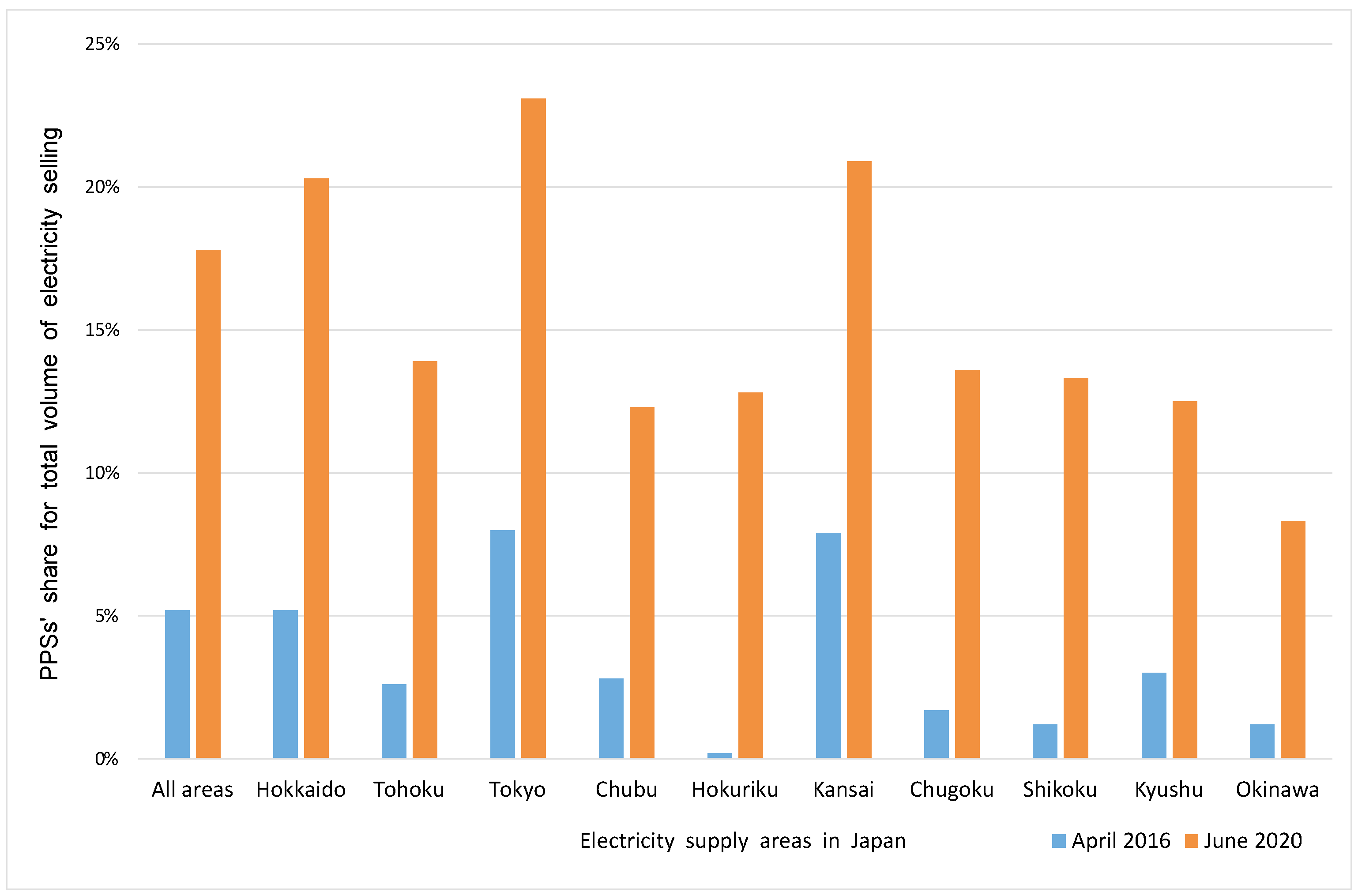
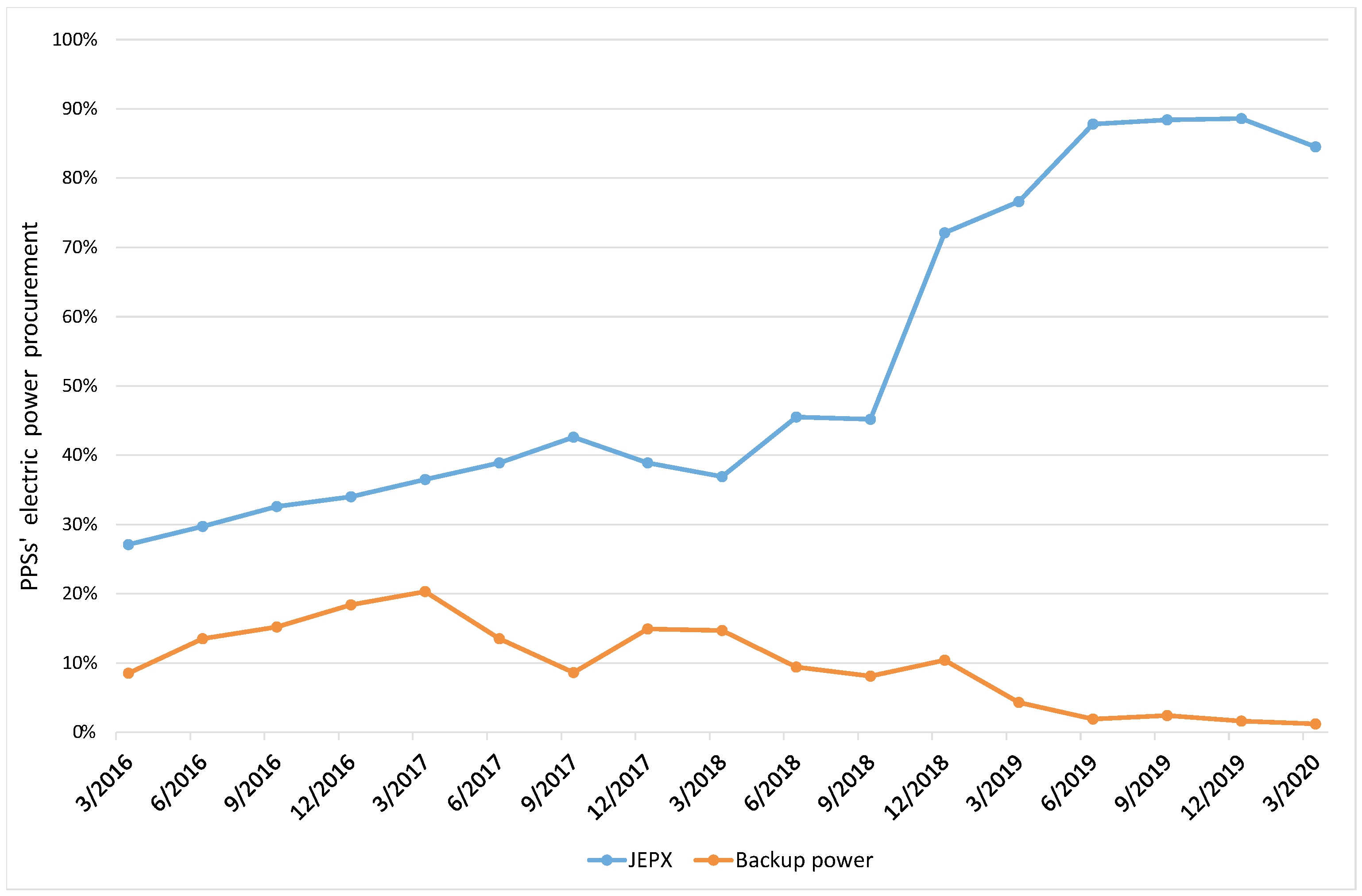


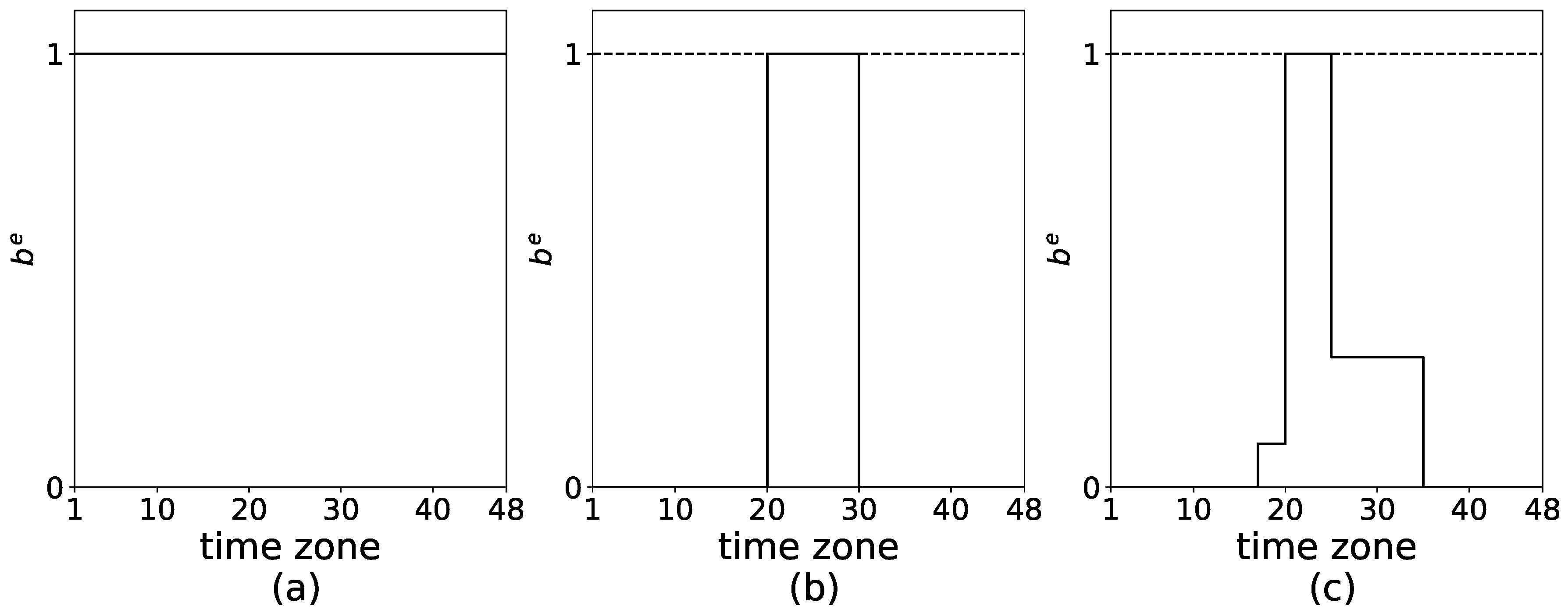
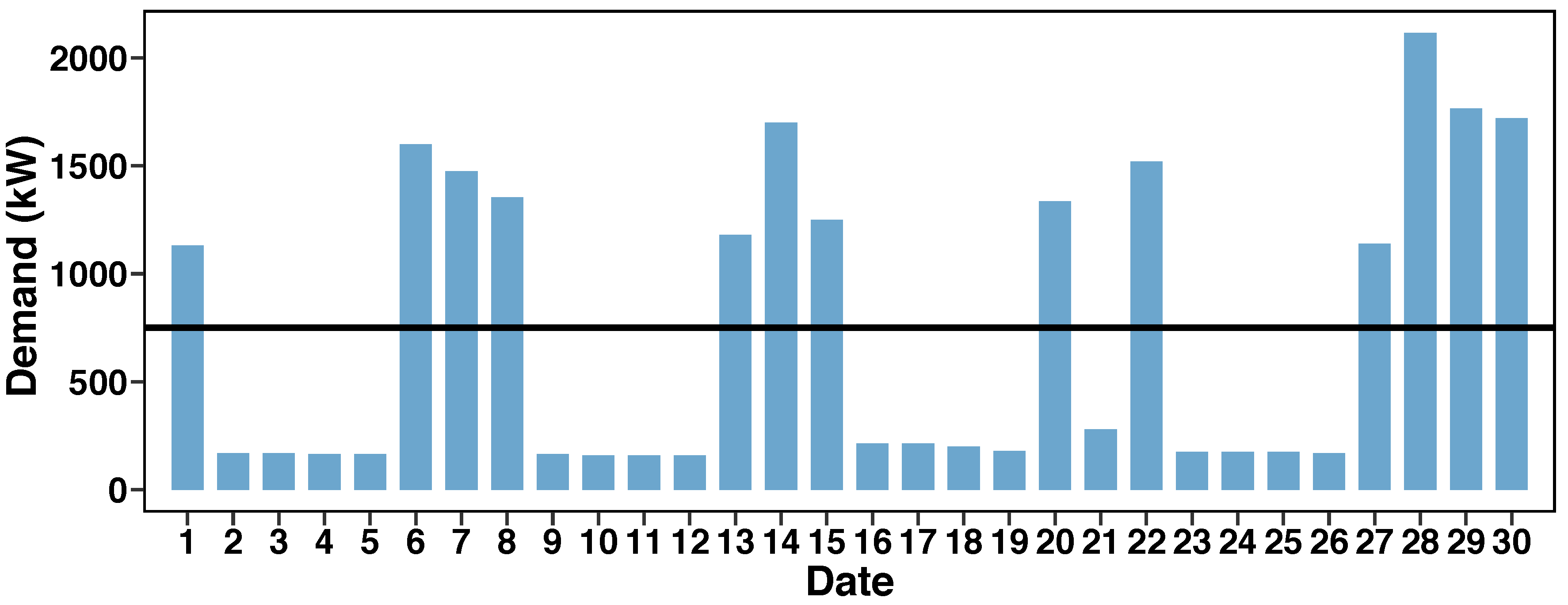
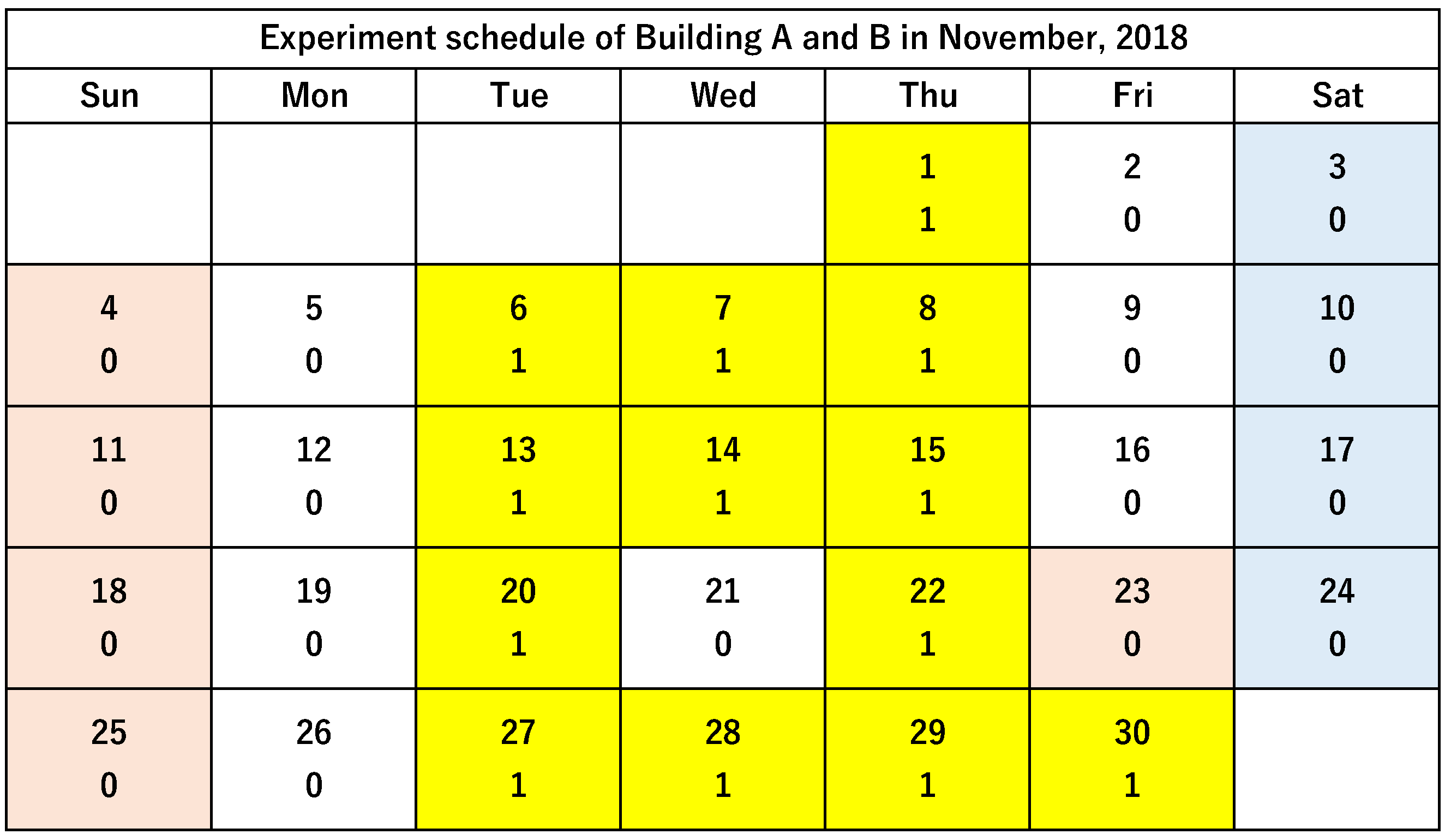
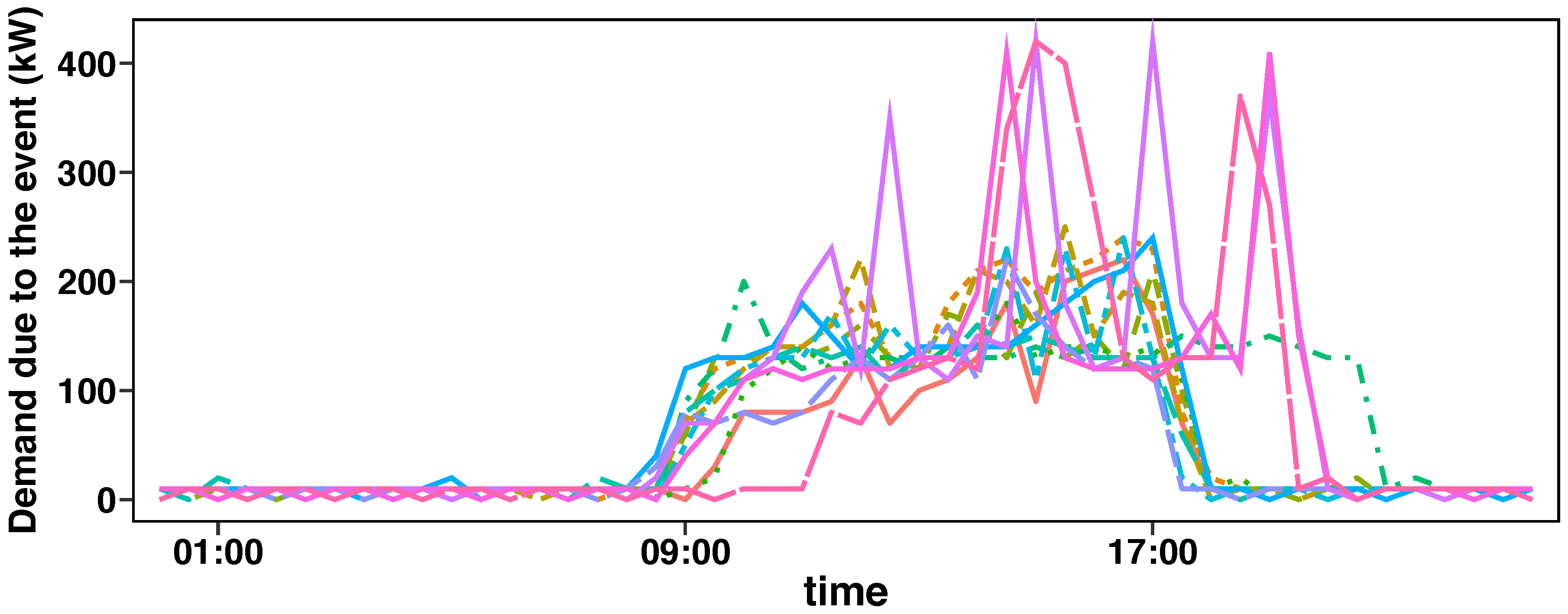
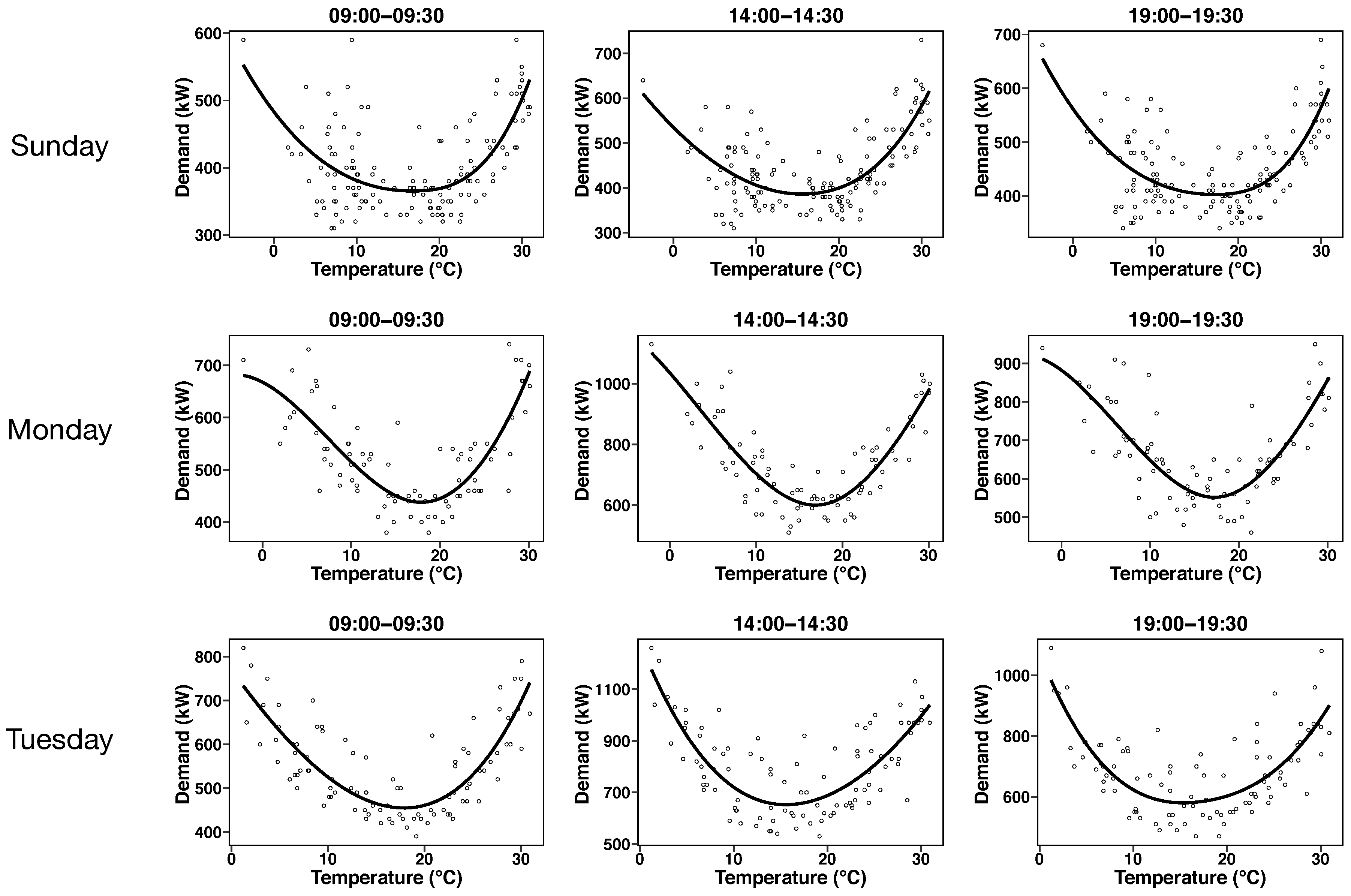
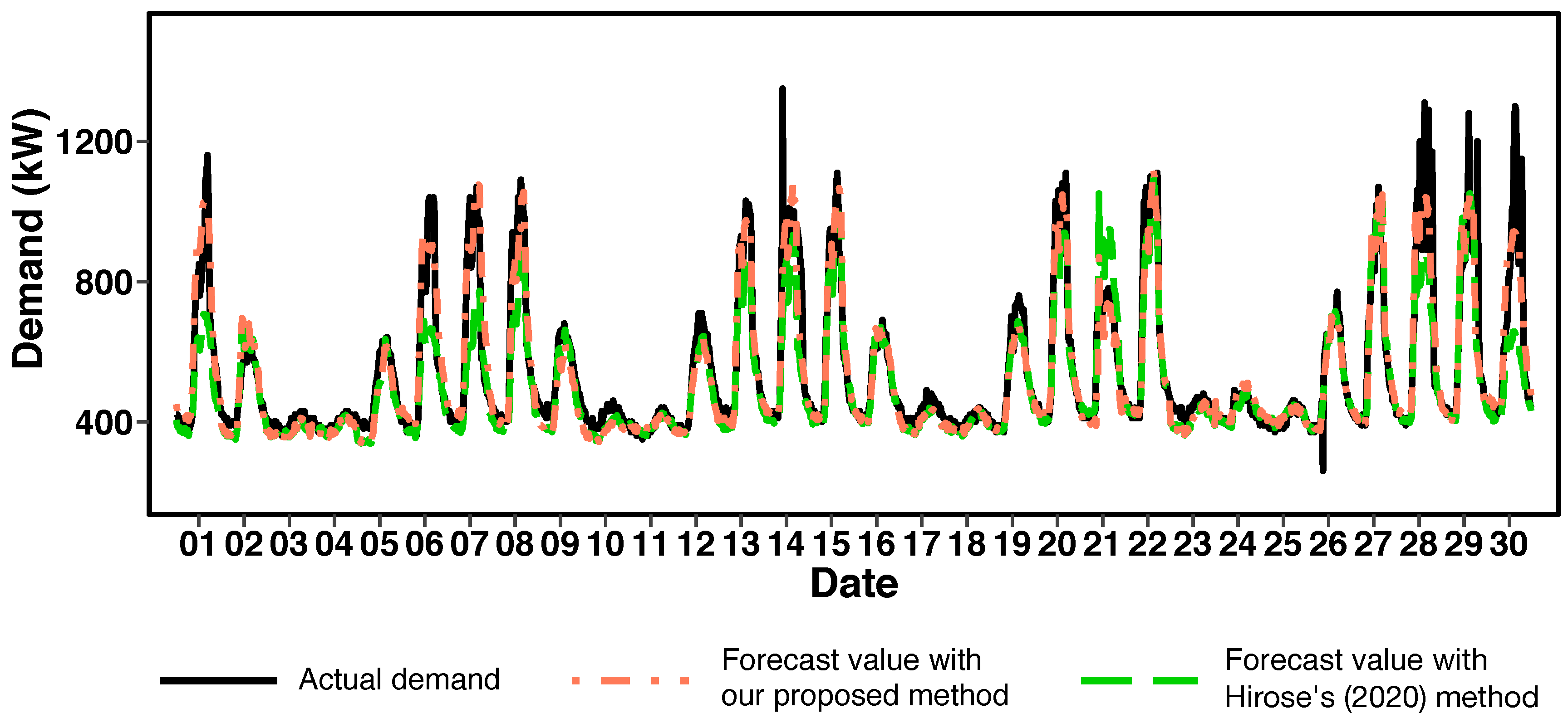
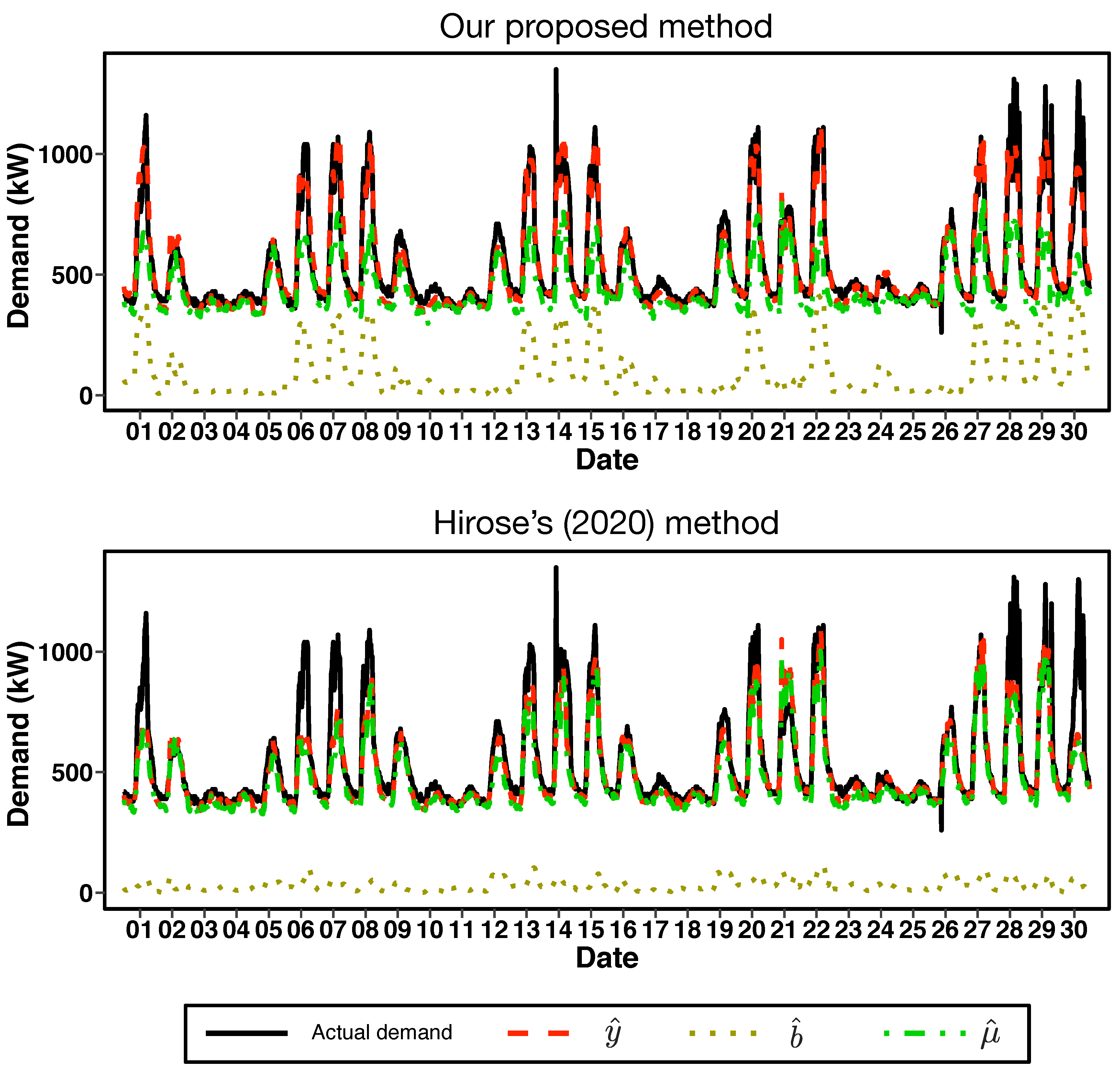
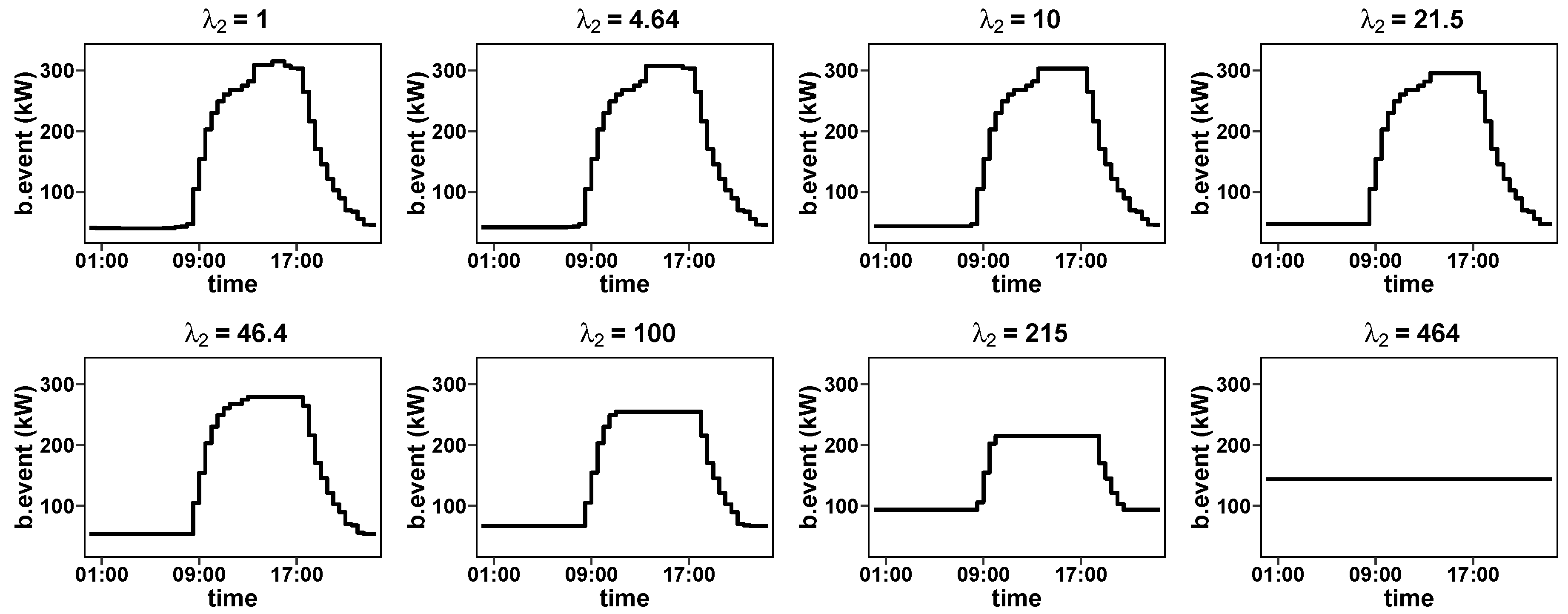
| VCM-S | VCM-S-Log | Sep-S | VCM-FL | VCM-FL-Log | Sep-FL | ||
| MAPE (%) | 9.4 | 8.3 | 9.4 | 7.9 | 7.7 | 8.0 | |
| RMSE (kW) | 40.1 | 37.1 | 40.2 | 36.2 | 35.6 | 36.4 | |
| Lasso | ARIMA | SVM | RF | XGB | LGBM | Hybrid | |
| MAPE (%) | 11.0 | 11.8 | 9.1 | 9.4 | 9.6 | 9.8 | 8.2 |
| RMSE (kW) | 46.5 | 52.3 | 42.1 | 41.3 | 42.7 | 41.7 | 37.1 |
| VCM | VCM-Log | Sep | Lasso | ARIMA | SVM | RF | XGB | LGBM | |
|---|---|---|---|---|---|---|---|---|---|
| MAPE (%) | 8.9 | 8.9 | 9.1 | 10.7 | 12.0 | 9.7 | 10.2 | 11.1 | 10.8 |
| RMSE (kW) | 45.5 | 46.1 | 45.8 | 50.3 | 54.1 | 48.8 | 48.2 | 52.8 | 50.4 |
Publisher’s Note: MDPI stays neutral with regard to jurisdictional claims in published maps and institutional affiliations. |
© 2020 by the authors. Licensee MDPI, Basel, Switzerland. This article is an open access article distributed under the terms and conditions of the Creative Commons Attribution (CC BY) license (http://creativecommons.org/licenses/by/4.0/).
Share and Cite
Hirose, K.; Wada, K.; Hori, M.; Taniguchi, R.-i. Event Effects Estimation on Electricity Demand Forecasting. Energies 2020, 13, 5839. https://doi.org/10.3390/en13215839
Hirose K, Wada K, Hori M, Taniguchi R-i. Event Effects Estimation on Electricity Demand Forecasting. Energies. 2020; 13(21):5839. https://doi.org/10.3390/en13215839
Chicago/Turabian StyleHirose, Kei, Keigo Wada, Maiya Hori, and Rin-ichiro Taniguchi. 2020. "Event Effects Estimation on Electricity Demand Forecasting" Energies 13, no. 21: 5839. https://doi.org/10.3390/en13215839
APA StyleHirose, K., Wada, K., Hori, M., & Taniguchi, R.-i. (2020). Event Effects Estimation on Electricity Demand Forecasting. Energies, 13(21), 5839. https://doi.org/10.3390/en13215839





